Analyzing data from a million GA flights can yield interesting results.
Pilots have long suspected that when it comes to headwinds and tailwinds, the deck is stacked against them.
I think the late Bob Blodget, Senior Editor of FLYING Magazine, captured how most pilots feel about this when he wrote that “we all come to the conclusion that there are always more headwinds than tailwinds; and that the headwinds are always stronger than reported or forecast, and the tailwinds weaker.”
Blodget wrote those words in 1968 and died in 1973. In his time, we could only speculate about such things. But in today’s era of computerized avionics and big data, we can prove them.
My colleague Chris Wrather is a longtime friend, pilot, Bonanza owner, and A&P mechanic with a Ph.D. in operations research. Among other things, he oversees the SavvyAnalysis division of my company. Over the past four years, we’ve built a database of digital engine monitor data comprising more than a million flights flown by about 7,000 piston-powered general aviation airplanes.
Digital engine monitors typically capture data from myriad sensors between 10 and 60 times a minute. This means that for each of those million-plus flights, we’ve captured tens of thousands of data samples involving dozens of instrumented parameters. We’re talking some pretty big data.
Lately, Chris has been doing interesting research using this big data. When I mentioned the old more-headwinds-than-tailwinds conjecture to him the other day, he decided to do some number crunching to see if he could prove or disprove it empirically.
The deck is stacked
A couple of days later, he shared with me the results of his study of about 3,500 flights of late-model Cessna 182S Skylanes powered by Lycoming IO-540 engines. Chris said he chose this particular “cohort” for this study for two reasons: First, the Skylane cruises at a modest 140 knots, so the effects of headwinds and tailwinds should be greater than for faster aircraft. Second, every 182S is equipped with Garmin G-1000 avionics that captures both true airspeed (TAS) and groundspeed (GS), precisely the two parameters he wanted to study.
Chris wrote software to analyze the data from these 3,500 Skylane flights, locate the longest stable cruise segment of each flight, calculate the average TAS and GS during those stable cruise segments, and then plot those values and calculate the median TAS and GS. Here’s the chart that Chris sent me:
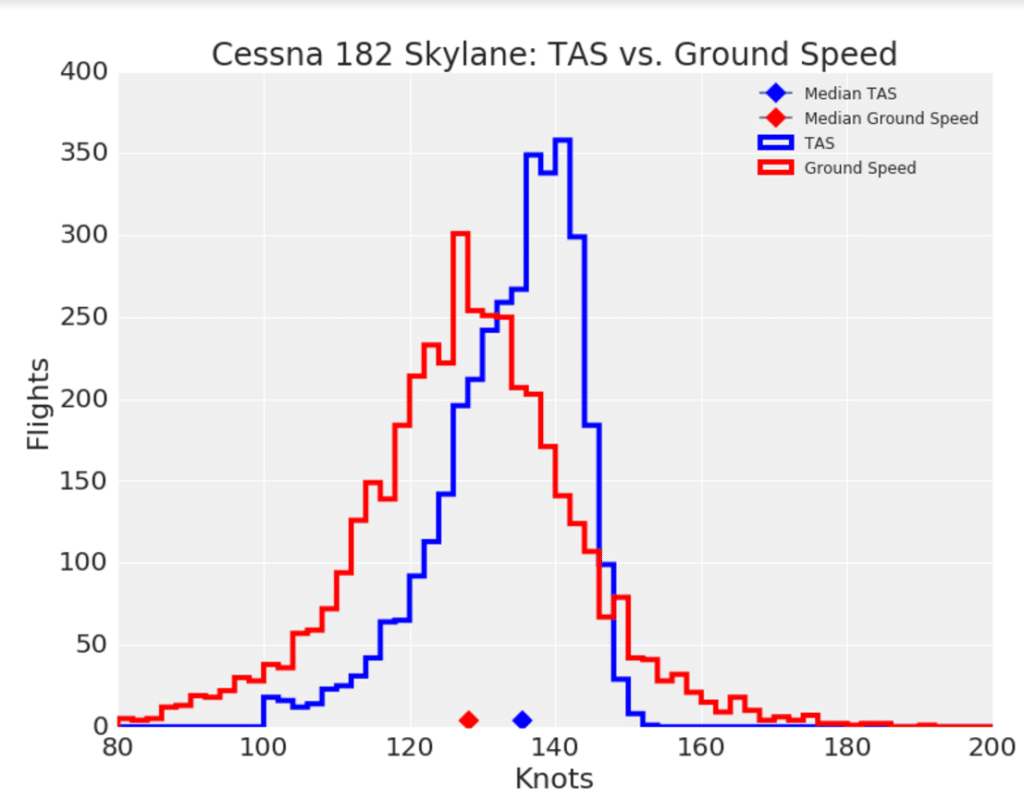
As the chart demonstrates, the median GS was 7.5 knots slower than the median TAS. This means that if you fly a 140-knot Skylane, the deck may be stacked against you by more than 5%. Ouch! (Compare that with the “house edge” in Las Vegas blackjack or video poker, both of which are less than 0.5%.)
Why it’s stacked
In my 50 years as a pilot and flight instructor, I’d always attributed this phenomenon to the obvious fact that we spend more time in headwinds than in tailwinds because the flights into headwinds are slower and take longer, while the ones with tailwinds are faster and finish more quickly. While that’s true enough, it doesn’t explain the results of Chris’ Skylane study. His analysis looked only at the average TAS and GS during each of the 3,500 flights, and ignored the length of those flights. (If he’d used time-weighted averages, the results would undoubtedly have been far worse.)
So, what exactly is going on here? Here’s how Chris explained it to me…
Imagine you’re cruising on a constant heading on a CAVU day. Visualize dividing the horizon into two 180° arcs, one extending 90° to either side of the airplane’s nose and the other extending 90° to either side of the airplane’s tail. (See Figure 2.)
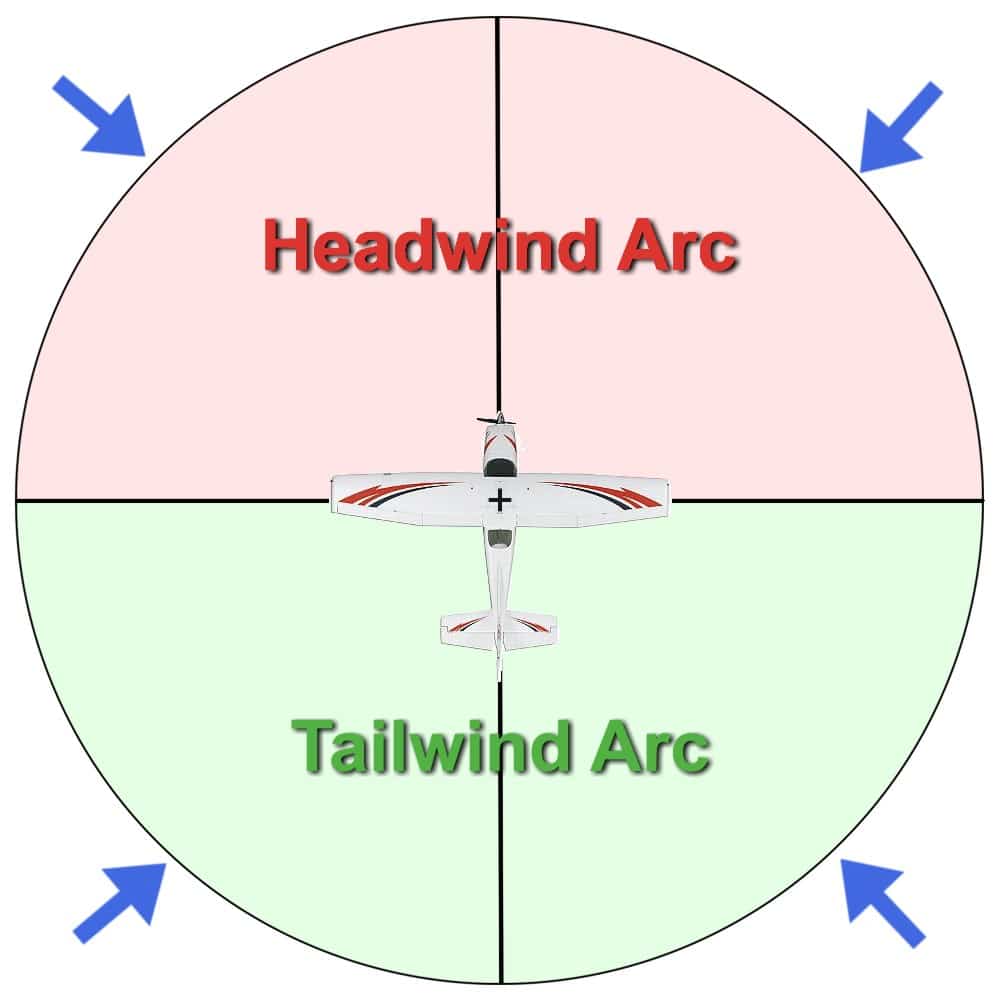
We might define wind blowing from a direction within the forward arc as a “headwind,” wind blowing from a direction in the aft arc as a “tailwind,” and wind blowing from exactly 90° to our track as a direct crosswind (neither a headwind or a tailwind). We might go further and postulate that if wind direction relative to our track is randomly distributed around the entire 360° horizon, we would expect the likelihood of having a headwind or tailwind to be a toss-up.
But this mental picture is simply wrong unless the wind is negligible. Here’s why…
If the wind aloft is significant and blowing from 90° to our track, we must crab into the wind to maintain that track. Crabbing into the wind reduces our GS, resulting in a GS that’s less than TAS, and transforming what we thought was a direct crosswind into a headwind. The wind direction would have to shift noticeably aft of the 90° point before it changes from a headwind to a tailwind and permits GS to exceed TAS. (See Figure 3.)
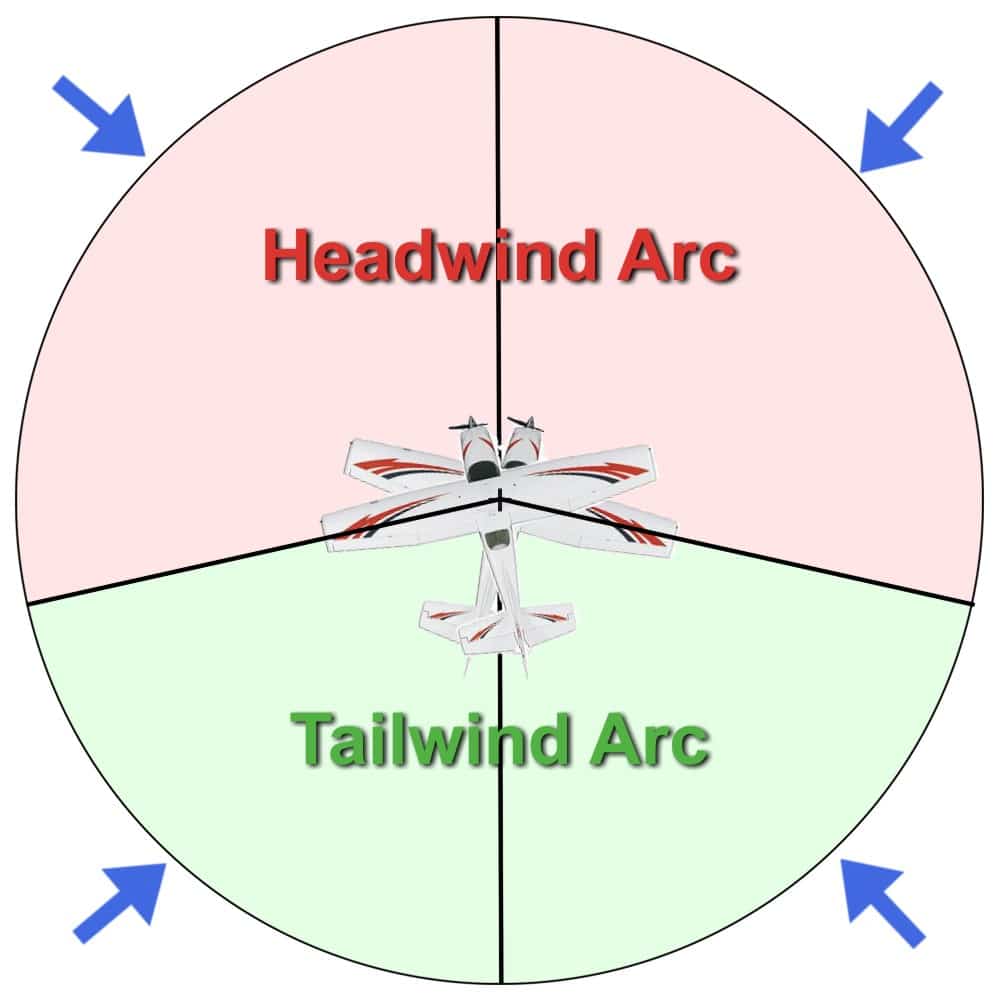
Thus if the wind is significant compared to our TAS, the forward “headwind arc” is more than 180° and the aft “tailwind arc” is less than 180°, causing headwinds to be more likely than tailwinds. The stronger the wind is, the more pronounced this effect is. This explains the 7.5-knot difference revealed by Chris’ Skylane study, and confirms that what we pilots have long suspected about the deck being stacked against us is not an old wives’ tale after all.
CHT studies
We’ve used our “big data” repository to do lots of other interesting studies, too. Some have focused on what I consider to be the most important factor affecting engine reliability and longevity: cylinder head temperature (CHT).
For example, I’ve long noticed that Lycoming engines seem to run hotter CHTs than Continentals, and I wanted to see if we could verify and quantify that. Chris crunched the numbers from several hundred thousand flights and came up with the following results (see Figure 4):
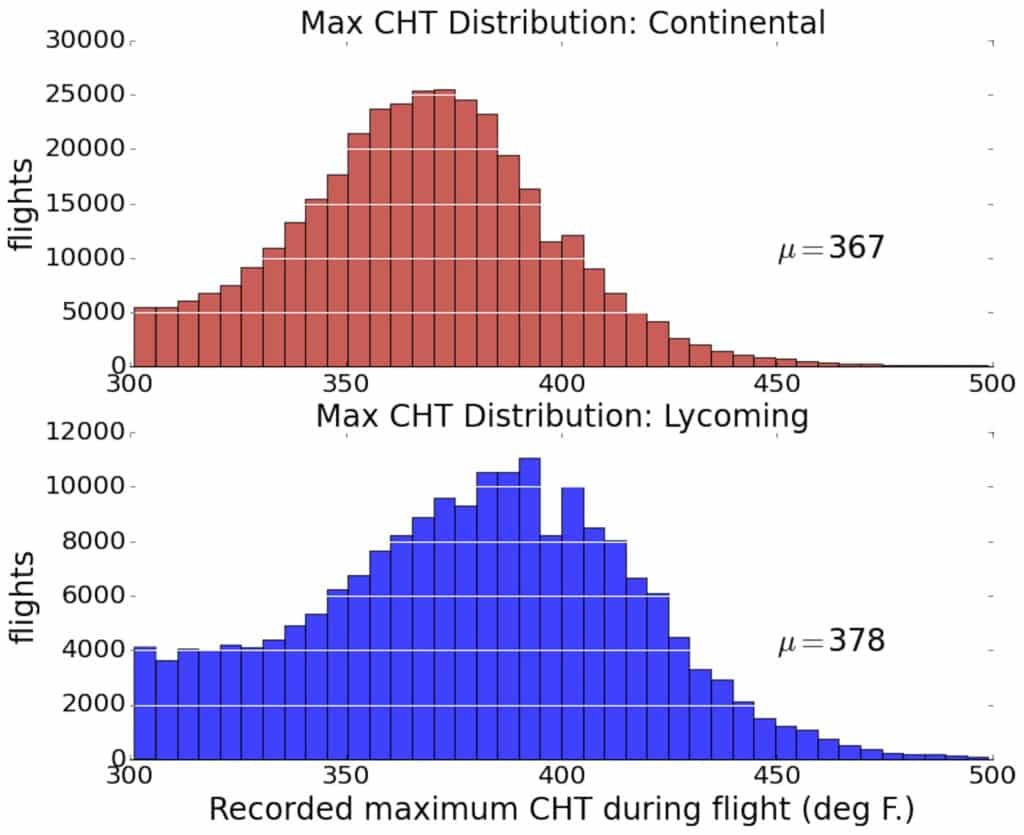
These charts demonstrated clearly that Lycoming CHTs (blue) do indeed run a good 20°F hotter than Continental CHTs (red). There are some good engineering reasons for this, notably the fact that Lycomings use sodium-filled exhaust valves that transfer heat from the valves to the cylinder heads more efficiently than do Continental valves. Fortunately, Lycoming cylinders employ a head-to-barrel junction design that can handle higher temperatures, which is why Lycoming sets its CHT red-line at 500°F compared to Continental’s more conservative 460°F.
One interesting aspect of this study which had me puzzled was the odd-looking double peak on the Lycoming CHT histogram. Drilling down further into the data revealed that the Lycoming IO-360-series was responsible for the double peak (we have a lot of RV flights in our database). It turns out that Lycoming originally spec’d the IO-360 ignition timing at a rather aggressive 25° BTDC (resulting in hot CHTs), and then later changed its mind and retarded the timing to a more conservative 20° BTDC (resulting in much cooler CHTs). It appears that there are now a mix of IO-360s in the field—some timed to 25° and some to 20°—accounting for the double peak.
Another thing I’ve noticed is that piston airplanes designed in the past 20 years or so (e.g., Cirruses, Columbias, Diamonds) have much more efficient cooling systems and much more even CHT distribution than legacy aircraft (e.g., Bonanzas, 210s, Saratogas). To find out just how much more efficient, we did a comparative study of normally-aspirated Cirrus SR22s and Cessna 210s, looking at the spread between the hottest and coolest CHT. The results speak for themselves (see Figure 5):
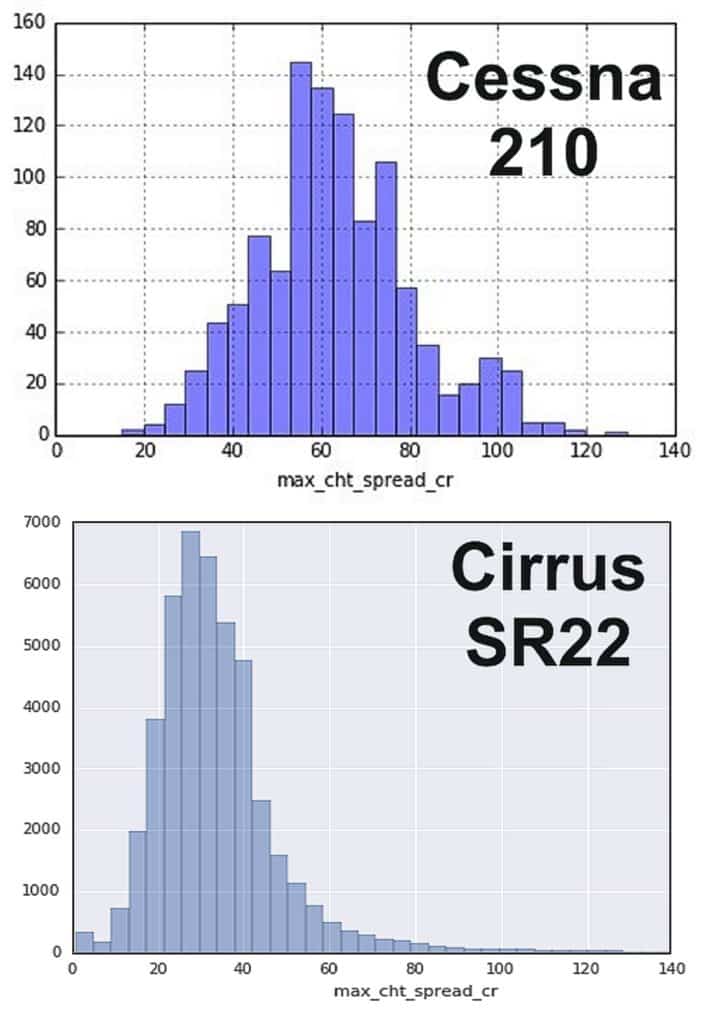
The modern cooling system design of the SR22 provides much tighter CHT spreads than the 60-year-old design of the cooling system in the Cessna 210. Drilling down further, it’s clear that the 210 cooling system’s problem is systemic, not random (see Figure 6):
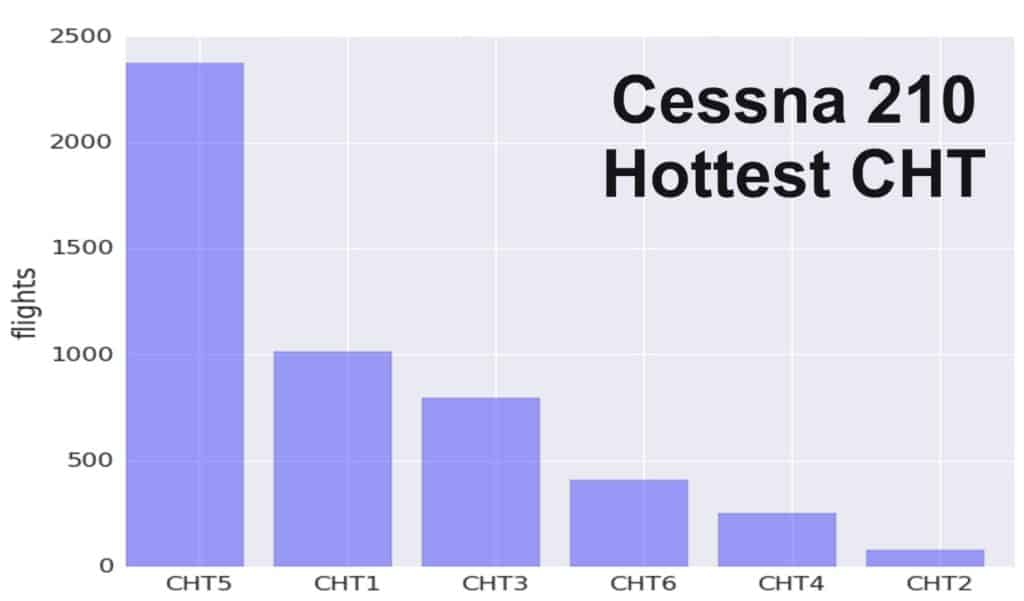
This chart makes it clear that the left (even-numbered) bank of cylinders have much better cooling than the right (odd-numbered) bank, and the right-front cylinder (#5) is almost always the hottest-running problem child. That suggests a fundamental design issue with the 210’s cooling system. Conventional wisdom holds that the problem is related to #5 being right behind the engine’s right-front-mounted oil cooler, making it difficult to obtain adequate cooling air. (More recent engine designs from Continental relocate the oil cooler to the back of the engine behind cylinder #2.)
But wait, there’s more!
This is just a taste of some of the cool results that can be obtained by mining and analyzing big data from piston GA aircraft. We’ve just scratched the surface.
I estimate that roughly 50% of the piston GA fleet is equipped with recording digital engine monitors capable of capturing real-time engine and flight data for analysis. I’m convinced the potential benefits of collecting and studying this data are enormous.
Sadly, however, the overwhelming majority of captured data is never extracted for analysis, and winds up in the proverbial bit bucket, forever lost. It amazes me how many aircraft owners have fancy data monitoring equipment but have never retrieved the recorded data and don’t even know how. One of my challenges is to convince aircraft owners to dump their captured data for analysis on a regular basis, much as they have oil filters inspected and oil samples sent to the lab. My hope is that the next generation of avionics will be able to “phone home” autonomously, disgorging captured data over the Internet without manual intervention.
Analysis of big data isn’t limited to studying groups of aircraft. By comparing data obtained from one particular aircraft against data obtained from a “cohort” of similar aircraft, it’s possible to provide important actionable information to aircraft owners. Software can automatically detect exceedances and outliers, and identify mechanical and operational problems that might otherwise go undetected.
You bought a plane to fly it, not stress over maintenance.
At Savvy Aviation, we believe you shouldn’t have to navigate the complexities of aircraft maintenance alone. And you definitely shouldn’t be surprised when your shop’s invoice arrives.
Savvy Aviation isn’t a maintenance shop – we empower you with the knowledge and expert consultation you need to be in control of your own maintenance events – so your shop takes directives (not gives them). Whatever your maintenance needs, Savvy has a perfect plan for you: